Once again, spooky season is upon us, and that means it’s time for the GeekMom Halloween Reading Roundup. This post is the fourth and final post for 2021, so don’t forget to check out the picture books, middle-grade, and YA roundups from the previous three weeks. Today’s roundup is all adult novels, so keep reading to see seven terrifying tales suitable for older readers only. If you can’t wait until next week’s post for more, why not check out our previous roundups? Links are at the bottom of the post. Happy Halloween!
Please note: This post contains affiliate links. All author and illustrator images are credited to themselves.

The Final Girl Support Group by Grady Hendrix
Grady Hendrix is slowly becoming one of my favorite horror/thriller authors, and also wrote one of my top books of 2020 (The Southern Book Club’s Guide to Slaying Vampires), so when I heard he had a new book out this summer it was an instant must-read for me.
In The Final Girl Support Group, we meet Lynnette Tarkington, the sole survivor of a massacre that took place twenty-two years earlier. Lynnette is a Final Girl, one of many young women who share the same traumatic story, each one the sole survivor of a massacre that has now been made into a movie franchise. She lives alone with only a single houseplant for company, a cage fitted around her front door, and an obsessive routine that involves only leaving her home when absolutely necessary, doubling and tripling back on herself to avoid being followed, and keeping multiple escape routes permanently in place.
Several of the Final Girls including Lynette have now come together to work through their trauma at a monthly support group. However, one day Lynnette’s worst fear comes to pass when one of the other girls fails to turn up. The group quickly realizes that she is dead and that one of their personal monsters finally won. Soon, Lynette begins to suspect that all of them are being targeted by a killer intent on taking out all the Final Girls. Now on the run, Lynnette has to try and figure out who to trust as revelations about her own history are made public and survival instincts kick in causing many of her friends to betray one another.
Unfortunately, this was possibly my least favorite Grady Hendrix book so far. While the plot was initially interesting, it never becomes more an average thriller with none of the visceral, squirming at the edge of your seat horror moments that Hendrix has become known for. Instead, this is a fairly standard slasher type book with many of the typical scenes you would expect and the only truly horrific moments coming in the form of flashbacks to the girls’ past massacres which are described in Hendrix’s usual gruesome style. Lynette herself is a very average female protagonist—although in this case, I suspect that was an intentional choice—and none of the supporting characters were especially interesting or well-rounded out. A week or so after reading and I’m struggling to even remember most of their names.
One thing I did thoroughly enjoy about The Final Girl Support Group was how it weaved famous slasher movie franchises into its own fictional world. Each of the Final Girls in Lynette’s support group experienced a massacre (and a follow-up movie franchise) loosely based on real slasher movie franchises including Halloween, Nightmare on Elm Street, Scream, and The Texas Chainsaw Massacre. Figuring out who was who in this world was a whole lot of fun, even having not seen some of the films the girls’ stories were based on. I also appreciated some unexpected LGBTQ representation, although it did teeter dangerously close to the Bury Your Gays trope.
All in all, this was a solid three-star book for me that didn’t blow me away but was still an engaging read that kept me up past my bedtime (even if it did fail to scare me while doing so). Hendrix’s fans may find this one a letdown, but I could also see it drawing in some new fans who prefer their horror a little less horrifying.
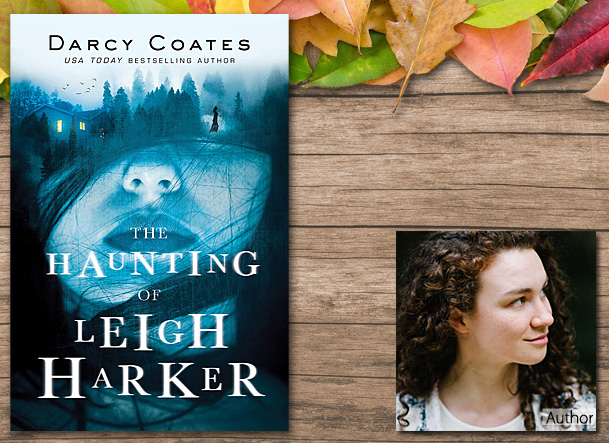
The Haunting of Leigh Harker by Darcy Coates
I first read one of Darcy Coates’ books last year and loved it, so I was thrilled to be offered the chance to pick up her latest title: The Haunting of Leigh Harker. While many of Coates’ books have similar titles (this is her fifth that begins with “The Haunting of”), this ended up being a truly unique book and unlike any ghost story I have read before.
The book begins right in the action with Leigh Harker lying in bed and aware of a mysterious something outside her bedroom door. Terrified, Leigh manages to survive the night and begins working to defend herself from what she names the Intruder. At the same time, she becomes very aware of a door she never paid much attention to before. Something about the door now makes her wary, a creeping sense of dread that soon has her convinced that the door must never open because behind it lives pure evil. But the Intruder doesn’t seem to be going away, and soon Leigh is experiencing strange visions of her home. She is determined to find out what has lured this being to her home after 15 years of living there peacefully and alone, but is she ready to find out the truth?
I will be honest and say that after the first few chapters I was ready to DNF this book because I was struggling to engage with Leigh as a character and found myself getting frustrated with her. A quick scan of other reviews online suggests I’m not the only one to feel this way. However, in one shocking moment that I never saw coming, the whole book changed and it became one of the most interesting takes on a ghost story I have ever encountered. From that point on I was instantly hooked and ended up devouring the rest of the book in just a few hours. It is difficult to write anything more without giving away spoilers, but I ended up connecting with both Leigh and one of the other characters introduced later on and truly loved the ending too.
This is the kind of book that you need to read without knowing anything about it so as not to ruin it, so I can’t say too much here, but if you enjoy books about ghosts, hauntings, and haunted houses, then you simply must read this one before you hear too much about it.
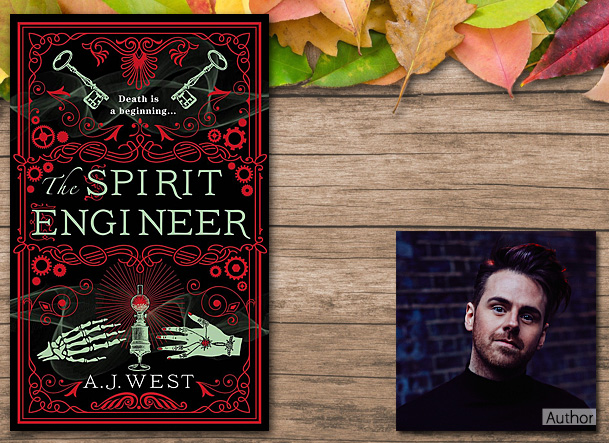
The Spirit Engineer by A. J. West
When I spotted a book blurb that included the Titanic, seances, Sir Arthur Conan Doyle, and Harry Houdini, I couldn’t resist picking it up—an impulse that only got stronger when I realized that The Spirit Engineer by A. J. West was based on a true story that happened in Belfast around 100 years ago.
William Jackson Crawford is a professor at the Belfast Technical Institute, a man of science desperate to work his way up through the ranks of society and sit at the top table during the Institute’s regular galas. For now, however, he is reliant on a busybody of an elderly benefactor as he tries to make ends meet for his wife and three children. His wife Elizabeth has been distraught since the death of her brother Arthur on the Titanic two years previously—something William is secretly harboring guilt over—and seems to be drifting away from him. Believing her to be having an affair, William instead discovers that his wife has been secretly attending seances at the home of the downtrodden Goligher family in the hopes of speaking with Arthur.
After a personal tragedy, and finding himself wrapped up in a high society bet that could raise his family’s fortunes forever, William becomes obsessed with the Golighers. He designs countless experiments to prove whether or not the family’s young medium Kathleen is truly in contact with the dead or whether everything he and his wife have experienced has been a hoax. As William’s mental state deteriorates and his relationship with Kathleen grows ever more unseemly, William’s grasp on reality weakens and threatens both himself and his family.
The Spirit Engineer was broken up into four parts (plus an epilogue) and I honestly felt as if the entirety of part one could have been condensed into a single chapter or a prologue. While intended to connect readers with the book’s characters, in particular, William and his family, it instead dragged on for what felt like far too long with nothing really happening. It wasn’t until part two when the Golighers are properly introduced that the story really kicks off.
Once it was going, The Spirit Engineer was a fascinating and twisted piece of historical fiction that kept me guessing right until the end about whether or not Kathleen’s abilities were real. The gothic style of writing reminded me of The Woman in Black or The Turn of the Screw with more psychological terrors than gross-out or jump scares. William’s guilt over Arthur’s death haunts him and colors his interpretation of what he experiences in the seances, as do his feelings regarding the other tragedies the family experience. I did find that the book’s big reveal seemed to come entirely out of the blue, but I found that it made me want to go back and read the book again to look for clues.
One thing I really loved about this book came after I had finished it. The author’s website is filled with detailed research into the real people on whom the story is based, including interviews with their living descendants. Reading this information and watching the numerous videos not only allowed me to connect more with the book but also reassured me that the descendants of these people are happy with how their relatives are being portrayed, especially as the portrayals are often unflattering and, on occasion, vary wildly from the truth.
The Spirit Engineer will appeal to anyone who enjoys historical and gothic fiction in the classic style, and I encourage you to read further about its two main characters to discover a fascinating true story to boot.
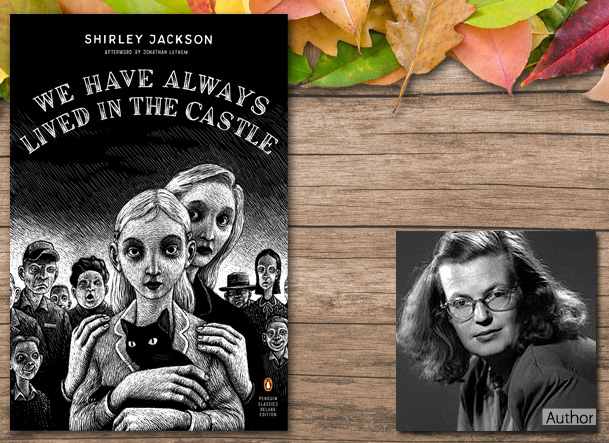
We Have Always Lived in the Castle by Shirley Jackson
With so many amazing new books coming out every year, it can be difficult to find time for the classics, but I’m still trying to work my way through some, and the spooky season is no exception. That meant that when I was offered a new edition of We Have Always Lived in the Castle by Shirley Jackson, I decided to give it a try, despite not being overly enamored by The Haunting of Hill House when I read that at the start of the year.
This book is told from the perspective of Mary Katherine (Merricat) Blackwood who lives a reclusive life with her older sister Constance, elderly Uncle Julian, and cat Jonas in a large secluded house at the edge of their small town. Merricat’s life is held together by routine, she and Constance do the same things on the same days every week with only Merricat venturing into town for library books and groceries. Soon it is revealed that the rest of Merricat’s family—her parents, brother, and aunt—were poisoned with arsenic in the sugar bowl at dinner, a crime for which Constance was tried and acquitted, but which has caused the family to become town pariahs.
One day, Merricat’s cousin Charles arrives unexpectedly to visit. While Constance is welcoming, Merricat believes that Charles is a malevolent entity who will only cause problems and disrupt the family’s perfectly organized life. She begins plotting ways to make Charles leave, but eventually, the feud between the two will change the Blackwood family’s lives forever once again.
This was a strange, slow book with a constant sense of foreboding from its very first paragraph. The odd Blackwood family who simultaneously re-live the day of the poisoning every day but also pretends it never happened are so well described, as is the house and grounds, that you very quickly find yourself feeling as if you live in the house alongside them. This leads to a strange sense of claustrophobia throughout the book and an ominous feeling of impending doom—I found myself wanting to hurry up and finish reading, not because I wasn’t enjoying the story but because I found myself growing ever more uncomfortable with every page turn and increasingly grateful of the novel’s brevity.
While the book’s big reveals weren’t exactly surprising to me, they also didn’t come across as dull or predictable, more distressingly inevitable—which added to the overall sense of discomfort. The writing style here was, naturally, a little old-fashioned given that this is a classic, but this also helped add to the disquieting feeling that infuses every page. All this means that while We Have Always Lived in the Castle might not be considered “scary” to a modern audience expecting jump scares and gore in every chapter, it might just be one of the most unsettling things you’ll read this year and the one that sticks in your head the longest.

You Feel It Just Below the Ribs by Jeffrey Cranor and Janina Matthewson
Despite falling away from the show recently, I still consider myself to be a big fan of Welcome to Night Vale and pick up all the books written by its creators, Joseph Fink and Jeffrey Cranor—in fact, you may well have noticed a book from the former in this year’s Middle-Grade Halloween Reading Roundup. You Feel It Just Below the Ribs is written by Jeffrey Cranor and Janina Matthewson, the co-creators of the podcast Within the Wires. The book is technically set within the same universe but you don’t need to have listened to any episodes of the show to make sense of the book.
The book takes the form of a fictional autobiography written by Dr. Miriam Gregory. It is largely chronological but with large gaps where months or even multiple years are missing, and it is filled with footnotes from the book’s supposed publisher that add historical context to Miriam’s words. The autobiography spans multiple decades beginning with her childhood around the 1920s, however, You Feel It Just Below the Ribs is an alternative history novel and so Miriam’s birth around 1912 coincides with the official start date of the Great Reckoning—an event we would consider to be the apocalypse. Growing up, therefore, in a post-apocalyptic world, we are first introduced to the hardships Miriam faced trying to fend for herself in a barren wasteland from a very young age. It is during her teens that she is introduced to a form of meditation she calls the Watercolor Quiet, and it is this that forms the spine of this novel/her life story.
Miriam discovers that the Watercolor Quiet can be used to effectively detach memories—a boon to a society filled with traumatized individuals and particularly children. The New Society, a worldwide government formed after the Reckoning, brings in new laws that forbid “anything that may cause tribal loyalties, including traditional families,” and Miriam finds herself at the heart of its efforts to enforce this, unwittingly dragged into a sinister government research program. However, the footnotes throughout the book point out that Miriam’s account varies wildly from established facts and often contradicts the notoriously transparent government’s records, which then begs the question—who is telling the truth?
You Feel It Just Below the Ribs is not the book for anyone who likes to come out of a novel knowing exactly what happened and how everything fits together. Throughout the whole thing, you are constantly left questioning what is true and what is not. While this is especially apparent in the final section, where Miriam comes into conflict with the people around her, even the earlier sections of the book are filled with doubt as events Miriam recounts fail to appear in any official records and it isn’t always clear what part of the world she is supposed to be in at any given point. She often recalls spending time with certain people who are well known in this alternative universe but recalls them doing and saying things that seem so wildly out of character to those editing the manuscript that they begin to wonder if she is actually writing an elaborate piece of fiction rather than an autobiography.
While many elements of this book are intensely difficult to read, I imagine more so for parents than any other group, I did love that Miriam is unambiguously portrayed as an LGBTQ woman right from the start. We even get to meet her wife and see a period of happy domestic life between them, although admittedly not for long in a book covering such a wide expanse of time. Parents will almost certainly find this story difficult to stomach at points given the New Society’s outlawing of family units and what that means for those with children, however, this is one of those stories that will give you a lot to think about.
Our society is increasingly tribalistic: Republican vs Democrat, Remain vs Leave, with people clustering themselves around certain strongly held beliefs on subjects like abortion or vaccine mandates and seeing themselves as part of a group who are fighting a righteous war against the opposing viewpoint. It is often said that in order to regain a more peaceful and less antagonistic society we need to reduce this type of tribalism, You Feel It Just Below the Ribs shows what could happen if that idea was taken to its own extreme.
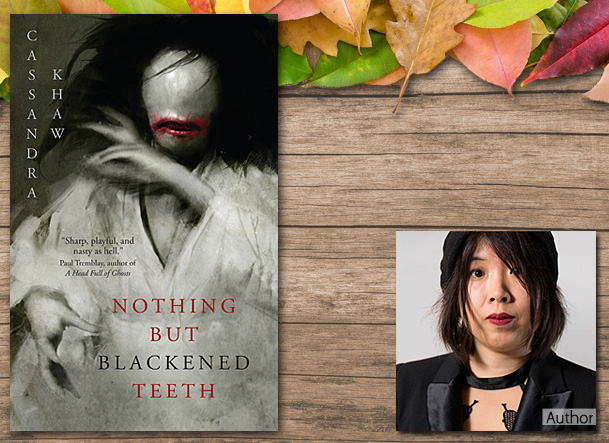
Nothing But Blackened Teeth by Cassandra Khaw
I picked up Nothing But Blackened Teeth by Cassandra Khaw despite its freaky cover art in the hopes of reading a totally new haunted house story from a different culture but ended up feeling supremely disappointed.
This short novella tells the story of a group of old friends who have met up for the first time in what seems to be years at a notorious Heian-era mansion in Japan. Two of the friends have always wanted to get married in a haunted house, which is the reason behind the trip. The house is supposedly home to the spirit of a bride who waited there for a groom who would never arrive and was eventually buried alive in its foundations so she could continue her waiting forever. Over the years, many other young women have also been buried there in order to provide the spirit with some company. As the night wears on and food and drink flow freely, the dream wedding destination becomes a nightmare because the lonely bride seems to want a new companion.
I’ll be honest, this book bored me to tears, and I would never have finished it if not for its blessedly short length. The cover is by far the scariest thing about it and I never felt even the slightest shudder of fear throughout—I have read scarier picture books than this. There are two huge flaws here that I think both contributed to the lack of scares and overall dullness of this book, and the first is the characters. Even by the end of the book, I barely knew anything about any of them beyond a few superficial or plot-critical facts. I never had any sense of connection between myself and the characters or even really between the characters themselves. I was told what their relationships were like, but I never saw it in action and, by the end, I wasn’t even bothered who lived or died.
Worse, however, was the writing style. This whole novella read as if the author was trying to show off how clever they were. It was filled with endless flowery metaphors and prose so purple it completely obfuscated what little plot there was. When the ghost bride first put in an appearance, I barely even realized it was happening thanks to the event being enveloped in lyrical writing to the detriment of actually telling the story.
With phrasing like, “a predatory stillness that drove a scream through the medulla oblongata” throughout, I’m frankly amazed I stuck this one out to the end.
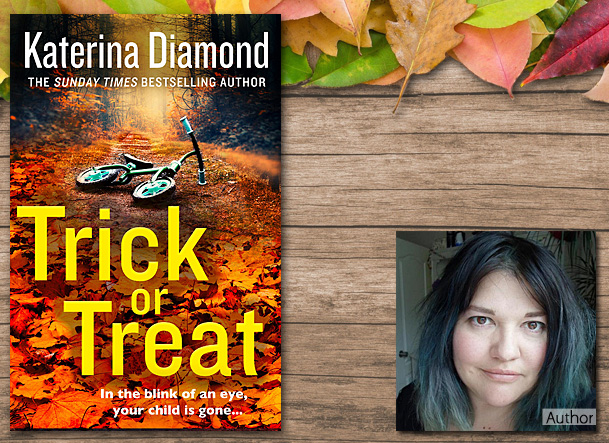
Trick or Treat by Katerina Diamond
Finally, if you’re looking for a book to read this Halloween that is connected to the season but only tenuously, then Trick or Treat by Katerina Diamond might be perfect for you. This detective thriller is the seventh book in the DS Imogen Grey series, but I was able to leap straight in without having read any of the previous books. It is initially set on Halloween, hence the title, but the holiday plays no part in the story as a whole.
On Halloween, six-year-old Marcus is kidnapped from the street outside his home and his mother receives a phone call demanding a ransom and no police involvement. Unfortunately for the kidnappers, the crime was witnessed by a teenage boy who had broken into his ex-girlfriend’s house to trash it and who anonymously reports the event. Soon, Detective Imogen Grey is on the scene, and she immediately suspects that there might be more to Marcus’ family than immediately meets the eye.
As she investigates, Imogen’s boyfriend and former colleague Adrian is wrestling with his own demons as he suffers through PTSD stemming from a sexual assault several months before. Personally investigating the crime he couldn’t bear to report, Adrian’s investigation begins to connect to Imogen’s causing conflict and confusion. Can Imogen find Marcus in time and will Adrian find the strength to share what happened with those close to him?
Trick or Treat could have been a fairly standard police procedural novel but managed to avoid this through its multiple interconnected plot lines and the well-developed characters who populate them. There’s Jason the teenage witness from a broken home who is desperate to avoid following his deadbeat dad and older brother into prison, Imogen who feels increasingly shut out from her own relationship and guilty for noticing that she’s starting to look elsewhere, and Adrian who is dealing not only with PTSD from his attack but lingering feelings of guilt for not fighting back, not to mention multiple side characters who all came across as having their own unique backstories—almost no one here felt two-dimensional.
The actual core plot of the book was a little predictable, but I felt this was done intentionally. The heart of this story was never about who took Marcus but rather why, and although even this part appears obvious on the surface, it leads into an impressively well-thought-out plot with a central antagonist who is both cunning and heartless. However, it was Adrian’s story that was the most compelling part of the book for me. It is rare to come across male rape victims in fiction, and also rare to see the after-effects of rape portrayed with such honesty. Adrian suffers from panic attacks and anxiety as well as PTSD, but these are compounded by his gender and former career in the police. He feels that someone like him should never have “allowed” the attack to happen and thus feels guilty and responsible for it. He struggles to attend therapy because doing so would force him to admit what happened, and even allows himself to take on punishments that could have been avoided by telling the truth. The rape affects not only his mental health but his physical health, relationships, and career. It is not something that happens one week and can be forgotten about the next, as often seems to happen to victims on television.
Despite not generally being a fan of the detective genre, Trick or Treat convinced me to give it a try more often, and I may well start that by reading more of the DS Imogen Grey series.
Further Reading
- Halloween Reading Roundup 2018
- Halloween Reading Roundup 2019
- Halloween Reading Roundup 2020: Babies – Grade School, Middle Grade, YA & Adult Part One, YA & Adult Part Two
GeekMom received copies of these books for review purposes.




